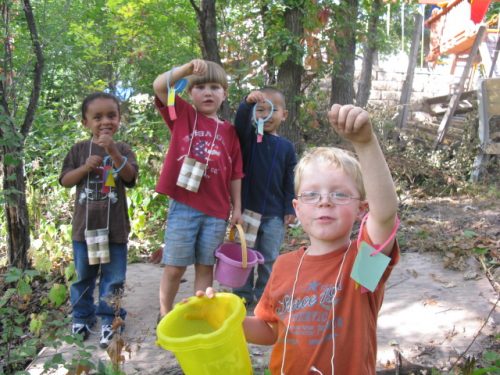Overview
Children search for the shapes and colors that define both our natural and built environments.
Materials
- Natural objects with defined shapes (e.g., eggs, leaves, nests, rocks, shells, stumps)
- Objects from the classroom for comparison (e.g., balls, blocks, dishes)
- Labeled shapes cut from paper
- Hole punch
- Yarn or pipe cleaners
Introduction
Nature is filled with objects of different colors, sizes, and shapes. Tree species can be identified by looking at several different features, including the shapes of their leaves. For example, willow trees have long, slender leaves; cherry trees have oval leaves; and cottonwoods have triangular leaves. But how do we view those shapes?
When you look in the direction of an object, light bounces off the object and into your eyes. The light passes through the cornea and the pupil into the lens. The lens focuses the image of the object onto the retina. The retina is located in the back of the eye. It is covered with light-sensitive cells called rods (receptors that work well in low light and that help us see shapes) and cones (receptors that work well in bright light and help us see detail and color). The rods and cones send messages through the optic nerve to the brain. The images they send are upside-down! Your brain turns the images over, interprets the messages, and tells you what you are seeing.
Eyes are important and easily damaged. That is why our bodies are built to protect them. Skull bones protect the eyes from injury. Eyebrows, eyelashes, eyelids, and tears all work to keep the eyes clean and protected from sunlight, dirt, and perspiration. Even with all this protection, things can go wrong. Cones and rods can be damaged or can malfunction, resulting in forms of blindness including color blindness or night blindness. The lens can focus the images in the wrong place causing people to be farsighted or nearsighted. And sometimes the eye muscles don’t work together properly. Be aware of differences in the ways the children in your class perceive the world as you facilitate these experiences.
Activity Instructions
Featured Experience – Shape Walk

Before the activity, make “shape necklaces” by cutting out shapes from construction paper.
Print the name of the shape on each cut-out and punch a hole in each.
Hold up each shape in turn, and ask the children to identify it. Ask: Do you see anything in our classroom that is this shape?
Give each child one of each shape, and show how to string the shapes on yarn (or pipe cleaners) to make necklaces or bracelets. You could also consider starting with just one shape and add more shapes over time.
Take a short walk outside to look for shapes. When you see an object that looks like one of the children’s shapes, hold up the appropriate cutout and say, “I spy something shaped like a____.”
Encourage the children to look for that particular shape in nature. Repeat with the other shapes.
Encourage the children to look for shapes on their own and say, “I spy something shaped like a ____.” With very young children, add colors to the description (e.g., I spy something that is yellow and is shaped like a_____________.”)
When you return to the classroom, hold up each cutout shape in turn. Ask: What did you see outside shaped like a _____? Which shapes did you see the most? Which shapes are your favorites?
Hungry for more? This lesson has many additional experiences to get children singing, dancing, reading, writing and playing all while learning about nature and shapes. Download the full activity.
Get the complete guide – 11 activities, over 130 environmental experiences for young learners.
Please remember that all PLT curriculum materials are protected under copyright law. Reproduce responsibly.
For additional resources that strengthen and enhance this lesson, register (for free!) and log in to access them.


